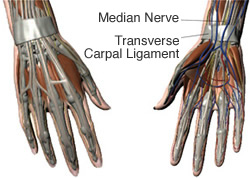Carpal Tunnel – Signs, Symptoms, Treatment

You know when you get a stuffed-up nose, how you can breathe but just barely? The same principle can be used for the tunnel in the human wrist, the Carpal tunnel.
The narrow, fibrous passage in the wrist that protects the median nerve is the Carpal tunnel. This is responsible for the movement and sensation in the hand and thumb, index and middle fingers. Your nerve can become congested, leading to tingling and numbness in the fingers, also known as Carpal tunnel syndrome.
What causes Carpal Tunnel Syndrome?
Anything decreasing the amount of space in the Carpal tunnel, increases the amount of tissue within the tunnel, or increases the sensitivity of the median nerve can lead Carpal tunnel syndrome.
This will cause the Carpal tunnel to compress the median nerve. This is known as nerve impingement and can lead to numbness, tingling, pain, and weakness in the affected fingers and thumb.
Carpal Tunnel Syndrome Symptoms
People who have jobs that require repetitive use of their hands often develop Carpal tunnel syndrome. Women are also more prone to develop Carpel tunnel syndrome then men.
Beginning as an ache in the wrist, the condition will then extend down to the forearm or up to the hand. As Carpal tunnel syndrome worsens, you may experience tingling or numbness in the fingers or pain radiating through the entire arm. You may also notice weakness in the hand and difficulty in grasping small objects. The condition often feels worse when first awakening in the morning.
How we treat Carpal Tunnel Syndrome
At Susquehanna Orthopaedic Associates, our goal for your Carpal tunnel syndrome treatment is to allow you to return to your normal function and activities, and to prevent nerve damage and the loss of muscle strength in your fingers and hands.
We begin with conservative methods to treat Carpal tunnel syndrome:
- Resting the hands
- Use cold packs to reduce inflammation
- Anti-inflammatory drugs
- Splints
- Physical therapy
Learn more about Carpal tunnel syndrome >
The Carpal Tunnel Release Procedure
If conservative methods don’t stop the pain and tingling in the fingers, we may opt to surgically relieve the pressure on the median nerve. This procedure is called endoscopic Carpal tunnel release.
The goal of this procedure is to relieve pressure on the median nerve and reduce symptoms of Carpal tunnel syndrome. The procedure restores muscle strength and dexterity.
At Susquehanna Orthopaedic Associates, we will only consider surgery if your symptoms haven’t improved after several weeks of nonsurgical treatment or if you’re showing signs of nerve damage and decreased strength in the fingers and/or thumb.
We perform an endoscopic procedure which is a thin, flexible tube containing a camera is put into the wrist through a tiny incision. A camera will guide the doctor as the surgery is performed with thin tools put into the wrist through a second small cut.
Endoscopic Carpal tunnel release surgery is not as invasive as open surgery. Since it involves only two tiny incisions, you will have less postoperative pain, less scarring, and a faster recovery than with the open procedure.
Learn how Susquehanna Orthopaedic Associates performs endoscopic Carpal tunnel release procedures.
Recovery from Endoscopic Carpal Tunnel Release
You can return home the same day, though surgery performed on the dominant hand may take longer to fully recover.
Carpal tunnel syndrome symptoms may still be present after the procedure, but most people report the symptoms are significantly reduced.
If you have tingling in your fingers or wrist pain, you may have Carpal tunnel syndrome.
Call us at 410-879-9636 or contact us online and let’s have a look and see if we can get you back to a pain-free situation.


